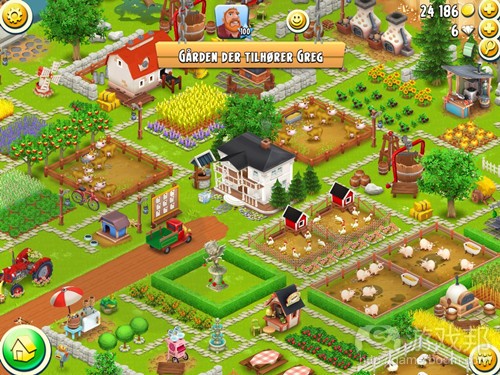如何在游戏中创造长期的用户留存
作者:Mikkel Faurholm
长期用户留存是面向App Store和Google Play发行游戏最重要的元素之一。因为市场上有许多免费游戏,所以你必须想办法让自己的游戏能够在一开始就吸引玩家的注意并让他们沉浸于游戏故事或主题等内容。一种被低估的长期用户留存策略便是通过创造玩家可能在游戏中变成什么的目标而吸引他们留在游戏中。有些游戏尝试着通过带有戏剧性的背景故事,能让玩家产生共鸣的“帮助者”以及在游戏环境中作为新的主导力量的任务去吸引他们的注意。这特别呈现于瞄准像如下成人那样的侧脸游戏/建造游戏。
关于这种类型的用户粘性策略所存在的问题是玩家很少会与“帮助者”进行互动,从而让这种策略只能在一开始发挥作用,而不能作为一种长期策略。在某些情况下这样的帮助者将变成像MS Word在1997所推出的Office Assistant Clippy,并最终将与我们的预期目的相违背。
为了提高长期用户粘性,游戏需要为玩家创造一个目标。清楚地呈现出这个目标,玩家可能变成什么,在他们面前会出现多酷的功能等等。很多人不能有效地创造这些目标。大多数玩家在游戏中都不知道自己接下来该做些什么。这与重新摆放家具能够帮你更好地卖掉房子是同样的道理。也许买家搬进去的时候家具不一定还是在原来的位置上,但是如果你能够重新摆放家具,便能够让他们看到自己未来的住处的雏形。
以下是一些有效地将这种模板呈现于玩家面前的优秀游戏例子,也有一些在这方面碰壁的游戏。
让我们先从正面的例子开始
Supercell的《Hay Day》在一开始便向你介绍了邻居Greg,他是一个热心的好邻居,在第一艘船到达时他会提醒你晒干草。而在玩家开始真正过上农民的生活前,友好的Greg会先向你呈现自己的农场。玩家在一开始便能够了解到游戏中可能出现的内容以及他们将面对什么。这是游戏长期吸引玩家的绝妙方法,他/她总是想要获得与亲爱的邻居相同的东西。
让我们继续看另外一个优秀的例子,同样是来自Supercell的一款游戏,《Clash of Clans》。这款游戏也发挥了同样的作用,即使是基于一种不同的方法。在游戏一开始将会有一个很贴心的女人告诉你要尽快创建一个大炮。很快地你将遇到其中的一个主要机制,也就是攻击其他玩家并赚取排行点数而在排行榜上进行攀升。在排行榜菜单上有着“最佳部落”和“最佳玩家”的标签,这便是这款游戏最突出之处。在此你将面对的是真实的玩家,而不再是Greg。
接下来让我们着眼于一些在这方面遭遇失败的游戏。
与《Clash of Clans》相同的是,《地下城守护者》在战役中引进了袭击机制,让玩家能够快速攻击其他玩家。看下图,左边是我自己在1个小时游戏后的情况,而右边则是游戏世界中最出色的玩家的成绩。其中的区别自然很明显,但却未能创造出目标和长期的吸引力。如此我还会愿意花大量的时间待在右边的地下城中吗?!
另外一个常见的误区便是游戏的结尾,最后的boss应该是较为隐秘且不容易被玩家所打败。这是8,90年代的电子游戏玩家想要的结果,但休闲玩家却不是如此。如果玩家不清楚自己的时间都浪费在哪里的话,他们便会对下一款游戏更感兴趣,因为他们不知道接下来会发生什么。瞄准休闲玩家的游戏就需要呈现给玩家前方可能出现的内容。所以开发者就必须在游戏中创造适当的目标。
人们并不需要打开像经典的平台游戏中那样的世界。如果你能够呈献给玩家通向最后的完整道路,他们更有可能继续游戏,甚至有可能愿意为游戏打开钱包。
你应该通过游戏玩法和有趣的机制与社交功能去吸引玩家的注意。但同时你也必须为其呈现出完整的轮廓,告诉他们接下来会发生什么,并创造明确的目标。
(本文为游戏邦/gamerboom.com编译,拒绝任何不保留版权的转载,如需转载请联系:游戏邦)
How to keep players playing – Long-term Retention
by Mikkel Faurholm
Long-term retention is one of the most important factors of releasing to the AppStore and Google Play. With that many F2P titles a game needs to initially hook the player and make the engaged about whatever the story/theme might be. A very underestimated long-term retention strategy is to engage player by creating a vision of what the player might become if some time, and possibly some money, is put into the game. Some games tries to engage through a dramatic back story and a ‘helper’ that the player hopefully sympathizes with and take on the task as the new ruler in this playful environment. This is especially present in the strategy/builders targeting adults like the ones listed below.
The problem with this type of engagement strategy is that the player seldom interacts with the ‘helper’, leaving this working only as an initial hook and not long-term. At some point this helper becomes like Office Assistant Clippy from MS Word in 1997 and it actually ends up working against the intended purpose.
To heighten the likelihood of engaging a player long term, the game needs to create a vision for the player. Visualize the goal, what the player can become, and what awesome features are ahead. People are terrible at creating these visions themselves. Most people cannot see passed what it in front of them right now. It is the same reason that rearranging furniture will help you sell your house. The furniture are still not going to be there when the buyer moves in, but by rearranging your furniture you’ve successfully created a vision that the buyer can process. enough real estate though.
There are some great examples of games where this vision is presented effectively and feasible to the player – and then there are some examples of games absolutely failing at doing so.
Let’s start with the good
Supercell’s Hay Day introduces your neighbor, Greg, in the very beginning of the game, and while Greg just like in the examples above, seem like a nice and helpful fellow, he is sure to annoy the hay out of you by the time the first boat arrives. But Hay Day and at the time friendly Greg does one very clever thing before releasing the player out into the wonderful life as a farmer – show you Greg’s farm. Instantly the player is introduced to what is possible within the game, what the player has in store. This is a brilliant way to engage a player long term, wanting the same as his/her dear neighbor.
Mooving on to another great example, surprisingly also from Supercell. you guessed it. Clash of Clans. Clash of Clans ultimately does the same thing, though in a different way. Here you have the same initial hook through the very nice lady telling you quickly build a cannon before it is to late. (A monetization strategy which is most likely going to have a post of its own)
But quickly you are introduced to one of the main mechanics, namely attacking other player and earning ranking points to climb the leaderboard. In the leaderboards menu, there are the ‘top clans’ and ‘top players’ tabs that the player can investigate – and this is the brilliant part. Here you are introduced to real players, not a Greg, who’s village look like this:
Compared to the initial village any player starts out with, the one above looks pretty damn cool. Creating the vision!
Ok, before this turns into a post about how Supercell can’t do anything wrong, let’s have a look at some of the games that failed to do this, and paid for it.
Similarly to Clash of Clans, Dungeon Keeper introduces raiding in the campaign and attacking other player fairly quick, enabling the long-term engage, the carrot at the end of the dungeon, through other player’s awesomeness. The Screenshot on the left is myself after ~1 hour of gameplay. The one on the right is the leading player in the world. The difference is there surely, but not creating that vision and the long term engage. Do I want to spend hours and hours to get the dungeon on the right? not likely!
Another common misconception is that the end game, the final boss, should be concealed and not spoiled to the players. This might be how the players of video games in the 80s and 90s would want it to be, but it isn’t the case with the casual gamer. If a player cannot see where his/her time is going, the next free game might seem just as interesting, ’cause who knows whats around the corner. Games targeting the casual player needs to show whats around that corner. SO essential in order to create that vision.
Why do you think you are able to scroll all the way to the end of Candy Land in Candy Crush Saga?
People have no need for unlocking worlds like in the classic platformers. Show players the entire path to the end product and they are much more likely to keep on playing and maybe even throw in a dime or two to get there.
Engage your player, through gameplay, through fun mechanics and social features. But remember to keep them engaged by painting that picture for them, show them whats behind the next corner and create that vision.
What do you think? What makes you play the game over and over again? Is the ‘long-term vision’ important to you in a F2P game? (source:gamasutra)
上一篇:玩家不愿在游戏中花钱的10大原因


























.jpg)














 闽公网安备35020302001549号
闽公网安备35020302001549号